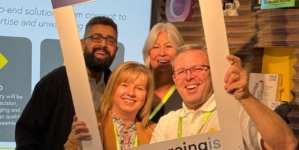-
Nutrivend selects Forterro’s Orderwise to support online expansion and streamline operations - April 11, 2025
-
ARROWXL LAUNCHES AMBITIOUS ZERO WASTE ROADMAP - April 8, 2025
-
THE BCMPA’S NEW CAMPAIGN DRIVES OUTSOURCING SUCCESS IN Q1 - April 7, 2025
-
BLACKOUT TECHNOLOGIES TARGETS TELEMATICS-INTEGRATED MOBILE DEVICE BLOCKING TO COMBAT SMARTPHONE DISTRACTION - April 1, 2025
-
Sparck Technologies awarded Royal designation - March 27, 2025
-
OpenADR Alliance announces first OpenADR 3.0 certified products with EVoke Systems, E.ON Energy and Universal Devices - March 25, 2025
-
Growing fulfilment and contract packer appoints new Managing Director - March 25, 2025
-
When is it time to invest in a WMS? Understanding the key trigger points - March 25, 2025
-
eCapital helps Vantage Recruitment on its journey to financial success - March 24, 2025
-
Hugo Beck Celebrates 70 Years of Packaging Innovation with Open House Events - March 20, 2025
WMS tech means ‘business as usual’ in the warehouse every day
When someone key to the daily operation of the warehouse leaves – a ‘go to’ person like a shift supervisor or pick team leader – it can create a void as they take their experience and knowledge with them. In some cases, their notice periods are just one week, at best one month, so full knowledge transfer does not often take place. Businesses can really struggle after losing operational know how that is built up over many years. And now, as a result of an industry wide logistics and warehousing skills shortage, it is increasingly difficult to replace these valuable workers when they do leave.
Many industries are facing a skills shortage, but new research from the Chartered Institute of Logistics and Transport (CILT) and Statista highlights that the logistics industry is going to be very hard hit. According to their report, 54% of logistics companies expect the skills shortage to further increase over the next five years and to face ongoing difficulties when recruiting new warehouse workers.
One of the key barriers to success is a lack of job-specific skills and relevant work experience, both of which can be overcome through the introduction of technology like a Warehouse Management System (WMS). In fact, after a WMS is implemented, with structured processes backed up by technology to take care of decision making, the impact on business as usual is much lower if a key person leaves.
As a whole, the logistics sector is investing heavily in technology to improve efficiency and accuracy. This has dual benefits because by automating workflow processes and key systems, these investments also protect companies from the negative effect of employee churn, an inevitable part of business life. Having a good system and optimised processes in place means that when people leave – after getting a new job or retiring – the business is far less affected than it would previously have been.
Without the WMS for instance, the business would have lost all the skills and knowledge that person had developed when they walked out of the door. The situation is comparable to a person trying to do a 1000 piece jigsaw without the box lid to illustrate what the overall picture should look like. Which doesn’t bear thinking about.
In many warehouses, especially those run with paper-based systems, processes and workflows can be overly complex. They have most likely evolved over time, with warehouse operatives making decisions independently about where to place incoming stock, or which orders to prioritise and how the warehouse walkthroughs should be organised. By introducing a WMS for instance, decisions like these are centralised based on pre-defined criteria. It means work schedules are systemised and optimised according to the day’s sales orders. It also reduces the reliance on particular employees’ knowledge of how the warehouse functions.
One of Indigo’s customers, a well-known food manufacturer, experienced exactly this positive outcome after losing one of their long-standing warehouse team leaders. They told us that before implementing Indigo WMS, an event like this would have really impacted their efficiency levels because daily decision making would have been disrupted. Our technology meant it was pretty much business as usual after their ‘go to’ supervisor left.
Worker shortages can be especially problematic for businesses that are seasonal, an upcoming concern in Q3 as many warehouses are ramping up for Halloween, Black Friday and Christmas. These key calendar events can create intense resourcing pressures and by using WMS technology, companies can begin to ‘smooth out’ the demand peaks. In addition to avoiding having to recruit larger numbers of temporary workers to cope with extra busy periods, when new staff do arrive, they can be fully efficient far more quickly. The system takes away the need to make so many decisions and guides them through the most efficient routes.
As a rule of thumb, a warehouse can expect to reduce its operating overheads during peak periods by up to 20% after introducing WMS technology. Traditionally, warehouses have coped with busy periods by increasing their labour resources – but this is expensive and impractical given the skills shortages. Using a WMS, key resource management tasks can be taken over by a system that is pre-programmed to follow structured rules and processes. Whatever happens with Brexit, we all know that the pool of labour is shrinking and there is only really one way to future proof logistics operations – with efficiency boosting technology and software automation.
Author
Eric Carter, Solutions Architect at Indigo Software
































